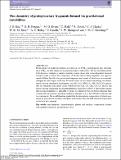Files in this item
The chemistry of protoplanetary fragments formed via gravitational instabilities
Item metadata
| dc.contributor.author | Ilee, J. D. | |
| dc.contributor.author | Forgan, D. H. | |
| dc.contributor.author | Evans, M. G. | |
| dc.contributor.author | Hall, C. | |
| dc.contributor.author | Booth, R. | |
| dc.contributor.author | Clarke, C. J. | |
| dc.contributor.author | Rice, W. K. M. | |
| dc.contributor.author | Boley, A. C. | |
| dc.contributor.author | Caselli, P. | |
| dc.contributor.author | Hartquist, T. W. | |
| dc.contributor.author | Rawlings, J. M. C. | |
| dc.date.accessioned | 2017-12-14T15:30:08Z | |
| dc.date.available | 2017-12-14T15:30:08Z | |
| dc.date.issued | 2017-11 | |
| dc.identifier | 251754728 | |
| dc.identifier | 99f5c67b-e39c-45a5-8e72-44798c02e3b7 | |
| dc.identifier | 000413765800016 | |
| dc.identifier | 85045882786 | |
| dc.identifier | 000413765800016 | |
| dc.identifier.citation | Ilee , J D , Forgan , D H , Evans , M G , Hall , C , Booth , R , Clarke , C J , Rice , W K M , Boley , A C , Caselli , P , Hartquist , T W & Rawlings , J M C 2017 , ' The chemistry of protoplanetary fragments formed via gravitational instabilities ' , Monthly Notices of the Royal Astronomical Society , vol. 472 , no. 1 , pp. 189-204 . https://doi.org/10.1093/mnras/stx1966 | en |
| dc.identifier.issn | 0035-8711 | |
| dc.identifier.uri | https://hdl.handle.net/10023/12333 | |
| dc.description | JDI, RB and CJC gratefully acknowledge support from the DISCSIM project, grant agreement 341137, funded by the European Research Council under ERC-2013-ADG. DHF gratefully acknowledges support from the ECOGAL project, grant agreement 291227, funded by the European Research Council under ERC-2011-ADG. DHF and WKMR also acknowledge support from STFC grant ST/J001422/1. MGE acknowledges a studentship funded by, and PC, TWH and AB acknowledge financial support from, the European Research Council (project PALs 320620). CH gratefully acknowledges funding from the European Research Council (ERC) under the European Union’s Horizon 2020 research and innovation programme (grant agreement no. 681601). | en |
| dc.description.abstract | In this paper, we model the chemical evolution of a 0.25 M⊙ protoplanetary disc surrounding a 1 M⊙ star that undergoes fragmentation due to self-gravity. We use smoothed particle hydrodynamics including a radiative transfer scheme, along with a time-dependent chemical evolution code to follow the composition of the disc and resulting fragments over approximately 4000 yr. Initially, four quasi-stable fragments are formed, of which two are eventually disrupted by tidal torques in the disc. From the results of our chemical modelling, we identify species that are abundant in the fragments (e.g. H2O, H2S, HNO, N2, NH3, OCS, SO), species that are abundant in the spiral shocks within the disc (e.g. CO, CH4, CN, CS, H2CO) and species that are abundant in the circumfragmentary material (e.g. HCO+). Our models suggest that in some fragments it is plausible for grains to sediment to the core before releasing their volatiles into the planetary envelope, leading to changes in, e.g., the C/O ratio of the gas and ice components. We would therefore predict that the atmospheric composition of planets generated by gravitational instability should not necessarily follow the bulk chemical composition of the local disc material. | |
| dc.format.extent | 16 | |
| dc.format.extent | 5135732 | |
| dc.language.iso | eng | |
| dc.relation.ispartof | Monthly Notices of the Royal Astronomical Society | en |
| dc.subject | Astrochemistry | en |
| dc.subject | Hydrodynamics | en |
| dc.subject | Planets and satellites: composition | en |
| dc.subject | Planets and satellites: formation | en |
| dc.subject | Protoplanetary discs | en |
| dc.subject | QB Astronomy | en |
| dc.subject | QD Chemistry | en |
| dc.subject | 3rd-DAS | en |
| dc.subject.lcc | QB | en |
| dc.subject.lcc | QD | en |
| dc.title | The chemistry of protoplanetary fragments formed via gravitational instabilities | en |
| dc.type | Journal article | en |
| dc.contributor.sponsor | European Research Council | en |
| dc.contributor.institution | University of St Andrews. School of Physics and Astronomy | en |
| dc.contributor.institution | University of St Andrews. St Andrews Centre for Exoplanet Science | en |
| dc.identifier.doi | https://doi.org/10.1093/mnras/stx1966 | |
| dc.description.status | Peer reviewed | en |
| dc.identifier.url | https://arxiv.org/abs/1708.01815 | en |
| dc.identifier.grantnumber | en |
This item appears in the following Collection(s)
Items in the St Andrews Research Repository are protected by copyright, with all rights reserved, unless otherwise indicated.

